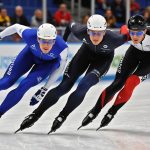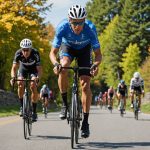Optimizing Recovery Strategies: Essential Post-Competition Protocols for Ultra-Endurance Athletes
When it comes to ultra-endurance sports, the journey doesn’t end at the finish line; it’s just the beginning of a critical phase known as recovery. For athletes who push their bodies to the limit in events like ultra-marathons, triathlons, and other long-distance competitions, effective recovery strategies are crucial for maintaining performance, preventing injuries, and ensuring long-term health.
Understanding the Importance of Recovery
Recovery is not just a passive process; it’s an active and deliberate set of strategies designed to help the body repair, rebuild, and adapt after intense physical exertion. Laurent Bosquet’s meta-analysis, which reviewed 182 studies on the subject, highlights the significance of recovery in achieving optimal performance. Bosquet notes that “the best competitive results are obtained with a reduction in training load of 40 to 60%”[4].
Also to discover : Optimal Strategies for Analyzing Aerodynamic Drag in Elite Speed Skating Competitions
The Science Behind Recovery
When athletes engage in high-intensity, long-duration activities, their bodies undergo significant stress. This stress leads to muscle damage, depletion of energy stores, and hormonal imbalances. The recovery process aims to address these issues by promoting tissue repair, replenishing energy stores, and restoring hormonal balance.
For instance, after a marathon or an ultra-marathon, the body’s muscle glycogen stores are severely depleted, and the muscle fibers are damaged. A well-structured recovery plan helps in replenishing these stores and repairing the muscle fibers, thereby preventing overtraining and reducing the risk of injuries[4].
Topic to read : Unleashing Your Potential: Mastering Off-Season Training Strategies for Competitive Cyclists”
Post-Competition Recovery Protocols
Immediate Post-Race Recovery (0-24 hours)
The immediate post-race period is critical for initiating the recovery process. Here are some key strategies:
- Hydration: Consuming about 500ml of water or a sports drink within the first hour after the race helps in replenishing lost fluids and electrolytes[3].
- Nutrition: Intake of carbohydrates and proteins within 30-60 minutes post-race aids in replenishing muscle glycogen and promoting muscle repair. A ratio of 3:1 or 4:1 carbohydrates to proteins is often recommended[3].
- Cool Down and Stretching: A gentle cool-down followed by static stretching helps in reducing muscle soreness and improving flexibility.
- Sleep: Ensuring adequate sleep is crucial as it allows the body to repair and adapt. Aim for 7-9 hours of sleep in the first 24 hours post-race.
Short-Term Recovery (24-72 hours)
In the days following a competition, the focus shifts to active recovery and gradual reintroduction of training.
- Active Recovery: Engage in low-impact activities such as cycling, swimming, or using an elliptical trainer. These activities help in promoting blood flow and aiding in the removal of waste products without causing further muscle damage[4].
- Compression Garments and Foam Rolling: Using compression garments and foam rolling can help in reducing muscle soreness and improving circulation.
- Gradual Return to Training: Gradually reintroduce light training sessions, focusing on low-intensity exercises. For example, for a 10km race, reduce the training volume by 50% for the first week, and for a marathon or ultra-marathon, reduce it by 60% for the first week, followed by a further reduction to 40% in the second week[4].
Long-Term Recovery and Training Adjustments
Periodization of Training
Effective recovery is closely linked to the periodization of training. This involves structuring the training year into specific phases, each with a focus on different aspects of fitness.
- Off-Season Recovery: After a long competitive season, athletes need a period of complete rest or significantly reduced training. This period, typically lasting 5-10 days, allows the body to regenerate without losing significant physical capabilities[5].
- Transition Phase: Following the off-season, a transition phase involving reduced training intensity and volume helps in maintaining physical fitness while allowing for recovery. This phase can last up to 15 days and includes activities like cycling, swimming, and strength training[5].
Nutrition and Energy Replenishment
Nutrition plays a vital role in the recovery process, especially in replenishing energy stores and supporting muscle repair.
- Carbohydrates and Proteins: Consuming a balanced diet rich in carbohydrates and proteins is essential. Carbohydrates help in replenishing muscle glycogen, while proteins support muscle repair and growth.
- Hydration: Adequate hydration is crucial throughout the recovery period. Athletes should aim to drink at least 8-10 glasses of water per day.
Practical Insights and Actionable Advice
Creating a Personalized Recovery Plan
Every athlete is unique, and what works for one may not work for another. Here are some steps to create a personalized recovery plan:
- Assess Your Needs: Consider the intensity and duration of your competition, as well as your individual physiological and psychological needs.
- Set Clear Goals: Define what you want to achieve through your recovery plan, whether it’s to improve performance, reduce injury risk, or enhance overall well-being.
- Consult Experts: Seek advice from coaches, nutritionists, and healthcare professionals to tailor your plan.
Example Recovery Plan
Here is an example of a recovery plan for an ultra-marathon athlete:
| Day | Activity | Intensity | Volume |
|---|---|---|---|
| 1-3 | Active recovery (cycling, swimming) | Low | 30-45 minutes |
| 4-7 | Gradual return to running | Moderate | 30-45 minutes, 3 times a week |
| 8-14 | Strength training and cross-training | Moderate | 2 times a week |
| 15+ | Full return to training | High | As per training schedule |
Quotes from Experts
- “The best competitive results are obtained with a reduction in training load of 40 to 60%,” – Laurent Bosquet[4].
- “It is better to arrive under-trained than over-trained. In a context of coherent and prolonged preparation, freshness is your best ally, especially for big events,” – Docdusport[4].
Additional Strategies for Enhanced Recovery
Sleep and Rest
Sleep is a critical component of the recovery process. It allows the body to repair and adapt, and it is essential for hormonal balance and muscle recovery.
- Aim for 7-9 Hours: Ensure you get adequate sleep each night to support your recovery.
- Naps: Short naps during the day can also be beneficial, especially if you are not getting enough sleep at night.
Mental Recovery
Mental recovery is often overlooked but is equally important as physical recovery.
- Visualization: Techniques like visualization can help athletes mentally recover and prepare for future competitions.
- Relaxation Techniques: Practices such as meditation and deep breathing can reduce stress and promote mental well-being.
Recovery is an integral part of an ultra-endurance athlete’s training regimen. By understanding the science behind recovery, implementing post-competition protocols, and creating personalized recovery plans, athletes can optimize their performance, reduce the risk of injuries, and ensure long-term health.
Key Takeaways
- Hydration and Nutrition: Proper hydration and nutrition are crucial in the immediate post-race period.
- Active Recovery: Engage in low-impact activities to aid in the removal of waste products and promote blood flow.
- Gradual Return to Training: Gradually reintroduce training to avoid overtraining and prevent injuries.
- Sleep and Mental Recovery: Adequate sleep and mental recovery techniques are essential for overall well-being.
By following these strategies, ultra-endurance athletes can ensure they are always at their best, ready to take on the next challenge with optimal performance and minimal risk of injury.
Nutritional Recovery Strategies
In the realm of post-competition recovery, nutrition plays a pivotal role. Ensuring athletes restore energy effectively can make a significant difference in performance and future training readiness.
Macronutrient Needs
After intense exertion, consuming adequate macronutrients is crucial. Both protein and carbohydrate intake are key to recovery. Proteins help repair damaged muscle tissues, while carbohydrates replenish glycogen stores depleted during the event. An effective strategy involves consuming a protein-rich meal with 20-30 grams post-exercise, along with 1.0-1.5 grams of carbohydrates per kilogram of body weight. This combination supports muscle synthesis and energy restoration.
Rehydration Techniques
Proper hydration is another cornerstone of post-competition strategies. Rehydration involves more than just drinking water; it’s about replacing electrolytes lost through sweat. Sodium-rich fluids, such as sports drinks, can facilitate fluid retention and recovery. Monitoring urine color can be a simple method of assessing hydration levels. Lighter shades typically indicate adequate hydration.
Supplements and Recovery Foods
Selecting appropriate supplements and recovery foods can further enhance the recovery process. Consuming amino acid supplements may aid in reducing muscle soreness and accelerating recovery. Foods rich in antioxidants, like berries or spinach, can help mitigate oxidative stress. Prioritising balanced nutrition along with intelligent supplementation will bolster recovery efficiency.
Psychological Recovery Techniques
Successfully navigating ultra-endurance events isn’t just about physical stamina; it’s equally about facilitating effective mental recovery. Athletes often face significant psychological challenges during and after such demanding competitions. This is where understanding mental recovery becomes vital.
Importance of Mental Recovery
Mental recovery is crucial for maintaining optimal performance and overall wellbeing. Athletes often experience mental fatigue, stress, and emotional exhaustion after an event, which can impede their capacity to prepare for future competitions. Prioritising mental recovery helps in resetting, refocusing, and maintaining a balanced psychological state, ensuring readiness for the next challenge.
Visualization and Mental Imagery
Visualization is a powerful sports psychology tool that can aid in mental recovery. By mentally rehearsing successful performance scenarios, athletes can enhance their confidence and reduce anxiety. This technique not only aids recovery but also preps them psychologically for future events. The practice of envisioning victory can lead to improved focus and the cultivation of a positive mindset.
Mindfulness and Stress Reduction Techniques
Employing mindfulness practices such as meditation and controlled breathing can significantly reduce stress levels. Simple techniques like focusing on breath or engaging in guided imagery can help athletes manage post-event stress, facilitating faster recovery. Integrating regular relaxation practices into their routines promotes better mental health and enhances resilience.
Case Studies and Expert Opinions
Insights into the world of ultra-endurance athletes reveal that their recovery experiences and strategies are just as important as their intense training routines. Hearing directly from these athletes offers a wealth of valuable information on optimal recovery practices.
Interviews with Elite Ultra-Endurance Athletes
Elite athletes share diverse recovery experiences, emphasizing the role of personalised strategies. These tailored approaches often include a mix of nutrition, hydration, and rest, underscoring the fact that there’s no one-size-fits-all solution. The common thread? Listening to one’s body.
Analysis of Successful Recovery Protocols
Successful recovery protocols, as observed in top athletes, highlight a few key components: consistency, monitoring, and innovation. Tools like heart rate variability trackers help tailor recovery to match physiological needs, ensuring athletes maintain peak performance levels.
Lessons Learned from Recovery Mistakes
Recovery mistakes are unavoidable, even for the best, but expert advice is invaluable in avoiding common pitfalls. Ignoring signs of burnout or overtraining, for instance, often leads to setbacks. Key takeaways stress the importance of balancing activity with adequate recovery time to prevent injuries and maximise performance. Remember, even professional athletes continue learning and adapting their routines as needed, ensuring they stay competitive and healthy.
Practical Tips and Routines for Athletes
Developing effective recovery routines is crucial for athletes aiming to maintain peak performance. Creating a personalised recovery plan can significantly benefit an athlete’s training regimen.
Creating a Personal Recovery Plan
To develop an individualized recovery strategy, it is important to first assess your specific needs and goals. Consider incorporating a variety of recovery techniques, such as active recovery exercises, nutrition adjustments, and adequate rest periods. Identifying what works best for your body requires experimentation and flexibility.
Daily Recovery Practices
Establishing daily habits can help athletes recover effectively. Examples include starting the day with a stretching routine to improve flexibility and reduce injury risk. Incorporate short meditation sessions to enhance mental wellness. Regular sleep patterns cannot be overstated in their importance for muscle repair and replenishment of energy reserves. Additionally, light activities like walking or yoga help maintain circulation and reduce soreness.
Setting Realistic Recovery Goals
Setting realistic recovery goals is essential for measurable progress. Determine achievable targets and timelines for each aspect of recovery. Regularly track progress by maintaining a recovery journal, noting fatigue levels, workout intensity, and personal feelings. This tracking helps adapt strategies, ensuring they remain effective and responsive to changing needs.
By adhering to these practical tips and routines, athletes can optimise their performance while reducing the risk of injury.
Understanding Recovery for Ultra-Endurance Athletes
When it comes to ultra-endurance sports, prioritising effective recovery strategies is crucial for enhancing athlete performance and minimizing the risk of injury. The nature of these sports demands significant physiological and psychological resilience. Post-competition, the body undergoes numerous processes aimed at repairing tissues, restoring energy, and rebalancing hormone levels.
The physiology of recovery involves several key aspects:
- Muscle Repair: During ultra-endurance events, muscles experience microtears which need to be repaired. A focus on protein intake and proper rest aids in this process.
- Energy Restoration: Glycogen stores deplete significantly, necessitating the intake of carbohydrates to replenish these crucial energy reserves.
- Inflammation Reduction: Recovery strategies often target the reduction of inflammation through techniques like cryotherapy or compression garments.
Ultra-endurance athletes commonly face challenges during recovery, primarily because their events push physical limits to the extreme. Chronic fatigue, increased susceptibility to infections, and psychological burnout are prevalent. Implementing structured recovery plans, which might include active recovery days, sufficient hydration, and psychological support, are essential to address these challenges effectively.
Incorporating these recovery strategies not only assists in maintaining peak performance for future events but also ensures the athlete’s long-term health and well-being.
Evidence-Based Recovery Protocols
Incorporating evidence-based protocols into your recovery regimen is vital to enhance performance and maintain athlete well-being. These protocols offer a structured plan to effectively utilise recovery techniques post-competition. Understanding and implementing these strategies can significantly improve both short-term and long-term athletic performance.
Active Recovery Techniques
Active recovery techniques are crucial for maintaining muscle health post-competition. Low-intensity exercises, such as walking or swimming, help clear lactic acid buildup and reduce soreness. These light movements enhance blood circulation, promoting faster muscle recovery by delivering vital nutrients and oxygen to fatigued areas. An example of an effective active recovery session might include 20 minutes of cycling at a relaxed pace or a gentle yoga session.
Rest and Sleep Strategies
Adequate rest is a cornerstone of recovery. Effective sleep post-competition is essential for muscle repair and cognitive function. To optimise sleep, create a calm, dark environment free from disturbances. Consistency in sleep routines bolsters recovery by aligning your internal clock, ultimately boosting performance. Prioritising quality sleep supports recovery of both body and mind.
Recovery Modalities
Complementing active recovery, recovery modalities such as cryotherapy and compression garments help reduce inflammation and enhance circulation. Manual therapy, including massages, targets muscle tension, promoting relaxation and flexibility. Physical therapy methods, tailored to injury specifics, underpin recovery and performance maintenance. Together, these techniques foster comprehensive recovery, preparing athletes for their next challenge.
Nutrition Strategies for Recovery
In the realm of sports and physical activity, nutrition recovery plays a pivotal role in restoring and enhancing performance. A balanced post-competition diet is essential for athletes to regain energy and repair tissues. To optimise recovery, it is crucial to pay attention to macronutrients, notably proteins and carbohydrates. These nutrients rebuild muscle fibres and replenish glycogen stores, respectively.
Timing is another vital component of fueling recovery. It is recommended to consume a meal or snack containing carbohydrates and proteins within 30 minutes to two hours after the competition or training session. This window maximises the body’s ability to absorb nutrients and accelerate recovery processes. For athletes, the right composition of post-event meals could include lean meats, leafy vegetables, and whole grains to ensure all nutritional needs are covered.
Incorporating supplements can also boost recovery efforts. Supplements such as protein powders, branched-chain amino acids (BCAAs), and electrolyte drinks help in meeting dietary requirements quickly and efficiently. However, it’s important to rely on whole foods as the foundation of recovery nutrition.
Successful recovery hinges on a mix of these elements, providing not just immediate benefits but also a sustained enhancement of athletic performance. Paying close attention to these strategies can make a difference in achieving optimal recovery post-competition.
Hydration Strategies Post-Competition
After intense physical activity, hydration recovery is essential to ensure your body returns to its optimal state. Fluid replenishment is not just about drinking water; understanding the nuances of fluid intake and electrolyte balance is crucial for effective recovery.
Rehydration Guidelines
The quantity of fluids required often depends on the duration and intensity of the competition. For events less than an hour, water may suffice. However, longer or more intense activities demand solutions rich in electrolytes to effectively address dehydration. Signs of dehydration to watch for include dark urine, dizziness, and fatigue, necessitating immediate hydration recovery interventions.
Electrolyte Replenishment
Electrolytes—such as sodium, potassium, and magnesium—play a pivotal role in muscle function and nervous system operations. Post-competition, electrolyte balance helps to recuperate from losses incurred through sweat. Drinking sports drinks containing necessary minerals or consuming foods like bananas or salty snacks can restore the electrolyte balance efficiently. Failing to manage fluid replenishment and electrolytes can impede recovery, prolong muscle soreness, and decrease future performance levels.
In essence, beyond just quenching thirst, strategic hydration recovery with a focus on electrolyte balance is indispensable for athletes aiming to maintain peak performance and health after competition.
Mental Recovery Techniques
Mental recovery plays a pivotal role in recharging ultra-endurance athletes for their next big challenge. The athlete mindset is not solely about physical prowess; it deeply involves mental fortitude. Effective psychological recovery strategies are crucial in navigating the immense stress and anxiety that follow intense competitions.
Firstly, understanding the importance of mental recovery cannot be overstated. It allows athletes to rejuvenate their minds, maintaining a balanced emotional state. One way to manage post-competition stress is through structured relaxation techniques. Techniques like deep breathing exercises help lower cortisol levels, offering immediate relief from stress.
Mindfulness practices serve as another critical component. They ground the athlete, fostering awareness of the present moment. This conscious focus helps in reducing anxiety and promoting emotional peace. Visualization is a powerful strategy as well. By imagining successful outcomes, athletes reinforce a positive mindset, enhancing confidence in future performances.
Incorporating these methods into daily routines can significantly bolster an athlete’s resilience. These practices not only offer mental recovery but also pave the way for improved performance by ensuring athletes remain mentally sharp and focused. Thus, mental recovery is integral to the holistic development of ultra-endurance athletes, equipping them to overcome both physical and mental hurdles effectively.
Creating a Personalized Recovery Plan
Designing an effective personalized recovery plan is essential for athletes seeking to balance peak performance with adequate rest. Each athlete requires unique recovery strategies that cater to their specific needs and schedules. This section delves into essential considerations and provides examples of recovery routines to guide athletes in tailoring their recovery plans effectively.
Factors to Consider in Planning
When devising a recovery plan, it’s crucial to factor in the individual differences among athletes. Recognizing one’s body type, fitness level, and personal limits can guide the choice of appropriate recovery methods. Balancing recovery activities with demanding training schedules ensures that athletes maintain high performance levels without overexertion. Setting realistic recovery goals is also vital; these should align with the athlete’s competition calendar and physical demands, preventing burnout and injuries.
Sample Recovery Routines
A well-crafted recovery plan might include varied routines tailored to different competition types. For daily routines, consider incorporating activities like stretching, hydration, and brief yoga sessions. Weekly recovery could involve massage therapy or relaxation practices to aid muscle recovery. For instance, a sprinter might integrate ice baths in a weekly schedule, while a marathon runner might focus more on nutrition and passive rest.
Monitoring progress helps in making necessary adjustments to the recovery plan. Regularly assessing the effectiveness of a recovery strategy ensures it remains aligned with the athlete’s evolving needs and training objectives.
Case Studies and Expert Insights
Exploring case studies of athlete recovery reveals fascinating insights into the diverse strategies used by top performers. Examining real-life examples allows us to understand how athletes tailor recovery to improve performance. For instance, professional athletes often undergo intense training and utilise expert opinions to optimise their recovery.
Incorporating insights from sports nutritionists and physiotherapists can be a game-changer. These experts provide tailored advice, ensuring that an athlete’s nutrition and rehabilitation protocols are perfectly aligned with their individual needs. Nutritionists often emphasise the importance of fuelling the body with a balanced diet rich in proteins and carbohydrates to support muscle repair. Simultaneously, physiotherapists focus on techniques like controlled stretching and massage to expedite muscle recovery.
Athlete recovery experiences are further illustrated by successful recovery protocols in ultra-endurance events. These protocols frequently encompass alternating periods of rest, active recovery exercises, and strategic nutritional interventions post-event. Such methods not only hasten the recovery process but also prepare athletes for subsequent challenges.
Expert opinions have consistently highlighted the importance of personalised and strategic recovery plans, especially tailored to the individual’s sport and personal needs. Collaborating with the right experts and learning from case studies can significantly enhance an athlete’s overall recovery strategy, leading to improved performance and longevity in their chosen sport.













